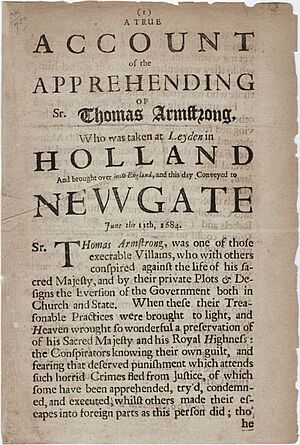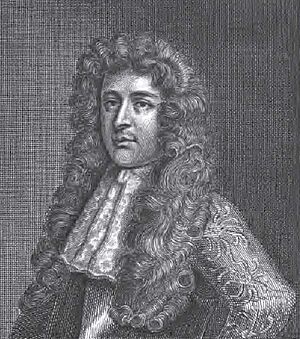Thomas Armstrong (English politician) facts for kids
Sir Thomas Armstrong (born around 1633 in Nijmegen – died June 20, 1684, in London) was an English army officer and a Member of Parliament. He was executed because he was accused of betraying the king.
His father, Colonel Sir Thomas Armstrong (who died in 1662), was a soldier who fought in the 30 Years War in the Netherlands. He also supported the king during the English Civil War. Because of this, he was put in the Tower of London twice by Oliver Cromwell, who ruled England at the time.
Contents
Sir Thomas Armstrong's Life
During a time when England had no king (called the Interregnum), Thomas Armstrong supported Charles II. He was part of a plan in 1655 to take over Chester Castle. He also helped carry money from a nobleman, Aubrey de Vere, to Charles II, who was living in exile. When he returned to England, he might have been put in prison for a year. In 1657, he married Catherine, whose uncle was a very important person named Edward Hyde, 1st Earl of Clarendon.

After the king returned to power in 1660 (this was called the Restoration), Thomas Armstrong became a captain in the Royal Horse Guards in 1661. In 1675, he was involved in a fight at a London theatre where he killed someone. However, he was forgiven because his opponent had started the fight.
A Soldier's Career
Armstrong served with James Scott, 1st Duke of Monmouth in France starting in 1672. He fought in a battle called the Siege of Maastricht in 1673. He also fought alongside the Dutch army in 1678 and was injured at the Battle of St Denis. In 1679, he helped stop a rebellion in Scotland called the Covenanter rising, fighting at the Battle of Bothwell Bridge. This was happening at the same time as a big scare in England called the Popish Plot, where people worried about a Catholic takeover.
Becoming a Member of Parliament
Because of his connection to the Duke of Monmouth, Sir Thomas Armstrong became a Member of Parliament for Stafford in March 1679. He served in the First Exclusion Parliament, which was a group of politicians who tried to stop the king's Catholic brother from becoming the next king.
Sir Thomas Armstrong's Final Days
In 1683, after a plan to harm the king called the Rye House Plot was discovered, Sir Thomas Armstrong was accused of a serious crime against the king. He became a wanted man and ran away to different cities like Cleves and Rotterdam. He was eventually caught in Leiden and sentenced to death by a judge named Judge George Jeffreys.
Sir Thomas Armstrong was executed in London on June 20, 1684. He was taken to a place called Tyburn. Even at the end, he said he was a true Protestant and wished he had lived more closely by his faith. Many people at the time felt that his trial was very unfair. After his execution, parts of his body were displayed in different places, which was a common, harsh punishment for treason back then.


